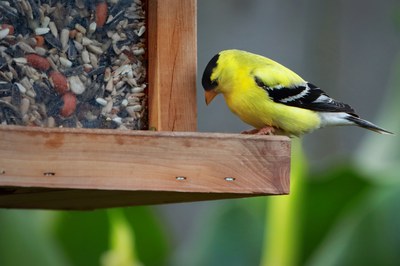Inviting Songbirds To Your Yard with Bird Feeding Stations
Would you like to get closer to nature? Put up a bird feeder.

Birds are wonderful to watch, especially in winter. Our feathered friends provide bright flashes of color, wonderful songs and curious movements. It’s a fun activity for everyone in the family.
Now is the time to take action. The weather is getting cold outside and birds are looking for a place to stay warm. Here are a few tips:
Provide good food. This is the most critical factor. Birds won’t visit your station if they do not like the food you offer. Black-oil sunflower and white proso millet seeds are highly desired by most birds. These seeds are rich in calories, which birds need to stay warm, and provide the best value.
Cracked corn and safflowers are useful additions to a seed mix. Niger thistle is preferred by goldfinches and house finches. Blue jays love peanuts.
Avoid seed mixes with wheat, millet, oats and rice. Birds pick through these inexpensive mixes, making a mess on the ground below.
Feeding songbirds can get expensive. Make a commitment to feed birds all winter or don’t feed them at all. Birds are especially vulnerable to hunger in late winter, when food sources in nature are most lacking. Buy seed in bulk to save money.
Get a variety of feeder boxes. A traditional wooden feeder mounted on a pole (see photo) will attract most birds. This feeder typically has a wooden roof and a clear plastic hopper that sits upon a shelf used by hungry birds for perching. The seeds drop down to the birds by gravity. This popular feeder is the best feeder to select if you use only one.
You can attract a wider variety of birds by adding other feeders. Nylon-covered wire cages filled with suet will attract woodpeckers and chickadees. Hanging tube feeders will attract finches.
Keep it safe. Birds won’t come to your station if they feel it is a dangerous place. Mount your feeders at least 5 feet high to discourage cats and other predators. Some type of cover, such as trees or shrubs, should be within 5 feet. This cover will provide a place of sanctuary for birds when threatened by predators.
Get a front-row seat. Place the feeder near a window where you can comfortably sit and watch the birds.
Millions of birds die from flying into windows every year. Place the feeder within 3 feet of a window or more than 30 feet away from a window. Birds that strike a window from a short distance are less likely to get harmed.
Give them water. All creatures need water to survive. Choose a bath with a rough surface and gentle slope, and one that is no more than 2 to 3 inches deep. Add branches or stones that emerge from the water to let birds drink without getting wet. Keep the bath full. Thermostatically controlled heaters will keep water from freezing.
Invite songbirds to your yard this winter. You and the birds will feel warm and happy.
Learn more about establishing a successful bird feeding station.
Written by Tom Kalb, Extension Horticulturist, NDSU. Edited by Ellen Crawford, NDSU Agriculture Communication. Photo courtesy of Ian Sane. Source: Bird feeding - Tips for beginners and veterans. University of Wisconsin: Madison.
